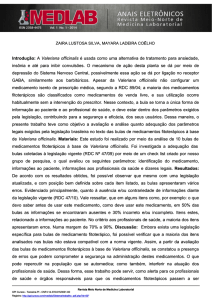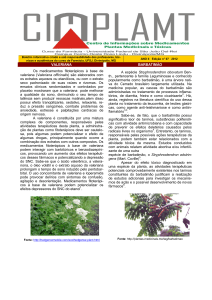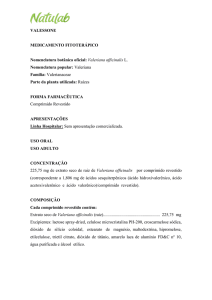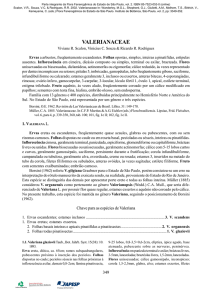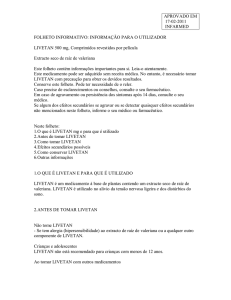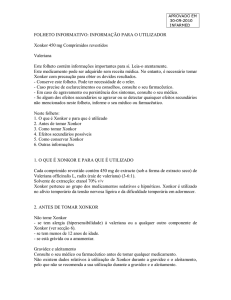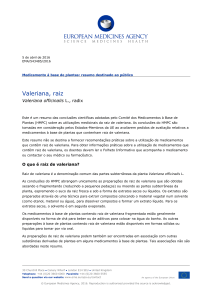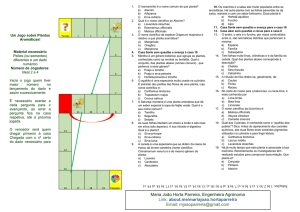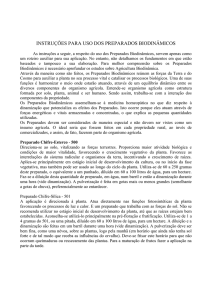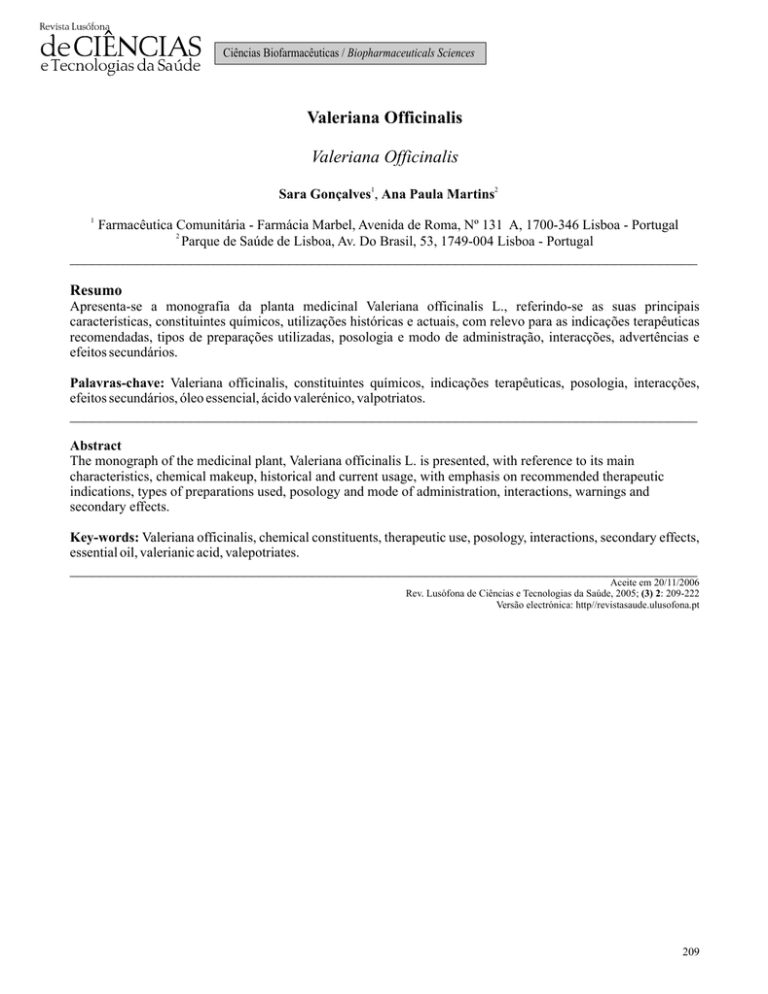
Ciências Biofarmacêuticas / Biopharmaceuticals Sciences
Valeriana Officinalis
Valeriana Officinalis
1
2
Sara Gonçalves , Ana Paula Martins
1
Farmacêutica Comunitária - Farmácia Marbel, Avenida de Roma, Nº 131 A, 1700-346 Lisboa - Portugal
2
Parque de Saúde de Lisboa, Av. Do Brasil, 53, 1749-004 Lisboa - Portugal
___________________________________________________________________________________
Resumo
Apresenta-se a monografia da planta medicinal Valeriana officinalis L., referindo-se as suas principais
características, constituintes químicos, utilizações históricas e actuais, com relevo para as indicações terapêuticas
recomendadas, tipos de preparações utilizadas, posologia e modo de administração, interacções, advertências e
efeitos secundários.
Palavras-chave: Valeriana officinalis, constituintes químicos, indicações terapêuticas, posologia, interacções,
efeitos secundários, óleo essencial, ácido valerénico, valpotriatos.
___________________________________________________________________________________
Abstract
The monograph of the medicinal plant, Valeriana officinalis L. is presented, with reference to its main
characteristics, chemical makeup, historical and current usage, with emphasis on recommended therapeutic
indications, types of preparations used, posology and mode of administration, interactions, warnings and
secondary effects.
Key-words: Valeriana officinalis, chemical constituents, therapeutic use, posology, interactions, secondary effects,
essential oil, valerianic acid, valepotriates.
___________________________________________________________________________________
Aceite em 20/11/2006
Rev. Lusófona de Ciências e Tecnologias da Saúde, 2005; (3) 2: 209-222
Versão electrónica: http//revistasaude.ulusofona.pt
209
Sara Gonçalves
Valeriana officinalis
Valeriana officinalis
Nome Científico
Valeriana officinalis L.
Scientific Name
Valeriana officinalis L.
Família
Valerianaceae
Family
Valerianaceae
Nomes vulgares
Erva-dos-gatos;
valeriana-menor;
valeriana-selvagem;
valeriana-silvestre.[26]
Common Names
Catmint; all-heal; garden
heliotrope; great wild
Valerian. [26]
Figura / Figure 1 - Valeriana officinalis
Habitat e distribuição
A valeriana é uma planta nativa da Europa (com
[26]
excepção da zona mediterrânica) e Ásia setentrional.
Aparece em lugares húmidos, de clima temperado,
principalmente florestas e margens de rios.[27]
É muito cultivada na Europa Central (França, Holanda,
Bélgica e Alemanha) e também na Europa de Leste,
[5,24,30]
Japão e E.U.A..
Fármaco
A parte da planta com interesse, que constitui o
fármaco é a raiz de valeriana Valerianae radix.
Definição
A raiz de valeriana consiste nos órgãos subterrâneos
inteiros ou fragmentados de Valeriana officinalis L.,
[7,8]
que compreendem o rizoma, as raízes e os estolhos.
[5]
Devem ser secos a uma temperatura inferior a 40ºC.
Segundo as farmacopeias portuguesa e europeia, o
fármaco inteiro seco deve conter não menos de 5ml/kg
de óleo essencial, e o fármaco fragmentado seco não
menos de 3ml/kg de óleo essencial.[7,8] Segundo a
farmacopeia europeia, o fármaco seco deve ainda
conter não menos de 0,17% de ácidos sesquiterpénicos
expressos em ácido valerénico (C15H22O2; Mr 234).[8]
Figura 2 - Raiz inteira seca de Valeriana officinalis
Figure 2 - Entire dry root of Valeriana officinalis.
210
Habitat and distribution
Valerian is a native plant to Europe (except for the
[26]
Mediterranean) and northern Asia. It appears in
moist places with mild climates, mainly in forests and
[27]
river margins. It is cultivated a lot in Central Europe
(France, Holland, Belgium and Germany) and also in
Eastern Europe, Japan and the U.S.A..[5,24,30]
Drug
The part of the plant of interest that constitutes the drug
is the valerian root - Valerianae radix.
Definition
The valerian root consists of thr entire or fragmentary
subterranean organs of the Valeriana officinalis L.
[7,8]
These include the rhizome, roots and stolons. They
[5]
should be dried at a temperature inferior to 40ºC.
According to Portuguese and European
pharmacopoeias, the entire dried drug should contain
[7,8]
not less than 5ml/kg of essential oil. According to
the European pharmacopoeia, the drug should also
contain not less than 0.17% of sesquiterpene acids
[8]
expressed in valerianic acid (C15H22O2; Mr 234).
Figura 3 - Raiz fragmentada seca de Valeriana officinalis.
Figure 3 - Fragmented dry root of Valeriana officinalis.
Valeriana officinalis
Valeriana officinalis
Características e Identificação
Characteristics and Identification
Os órgãos subterrâneos de Valeriana officinalis têm cor
cinzento-amarelada a cinzento-acastanhada.[7]
A sua identificação é extensamente descrita nas
farmacopeias portuguesa e europeia. São referidas as
características macroscópicas e microscópicas do
fármaco, apresentando-se um cromatograma onde se
identifica a presença do ácido valerénico e do ácido
hidroxi-valerénico, pela coloração violeta que dão com
solução de aldeído anísico, sendo também referido um
método de doseamento dos ácidos sesquiterpénicos
acetoxivalerénico e valerénico por cromatografia
líquida após extracção a quente com metanol
[7,8,27]
anidro.
A farmacopeia americana também descreve
semelhantes ensaios de identificação macroscópica,
microscópica e por cromatografia em camada fina.[9]
The subterranean organs of the Valeriana officinalis
[7]
have a greyish-yellow to greyish-brown color.
Its identification is extensively described in the
Portuguese and European pharmacopeias. The
macroscopic and microscopic characteristics of the
drug are referred, where a chromatogram is presented
and the presence of valerianic acid and hydroxyvaleric
acid is identified by the violet coloring that it gives off
with anisic aldehyde. There is also reference to a dosage
method of the sesquiterpene acids (acetoxivalerenic
and valerenic) through liquid chromatography after hot
[7,8,27]
extraction with anhydrous methanol.
American
pharmacopoeia also describes similar attempts at
macroscopic, microscopic and thin-layer
[9]
chromatography identification.
Medicinal use: History
Uso medicinal: História
A Valeriana officinalis tem sido usada como planta
medicinal há mais de 2000 anos, desde o tempo da
[17]
antiga Grécia e Roma onde já a usavam como
[38]
diurético, analgésico e espasmolítico.
Os seus usos terapêuticos foram descritos por
Hipócrates (460-377 a.C.)[17,24,35] e mais tarde por
Dioscórides (séc.I d.C.).[24] No século II, Galeno já
Tabela
6 -a insónia.[17,18,22,24]
prescrevia esta planta
para
Dioscórides e Galeno referem-se à valeriana nas suas
obras como “phu” (ou “fu”), uma expressão de aversão
[6,24]
devido ao seu odor desagradável. O nome valeriana
só começou a ser utilizado por volta dos séculos IX ou
X.[6,24] Pensa-se que a palavra terá vindo do latim
“valere” que significa estar saudável ou forte.[6,18,25]
Parece também que o nome da planta pode ter sido dado
em honra de Publius Aurelius Licinus Valerianus,
imperador de Roma entre 253 e 260.[25]
Foi referido por Galeno o uso da valeriana no
[25]
tratamento da epilepsia em crianças e adultos. Nos
finais do século XVI, o italiano Fabius Columna, que
sofria da doença, relatou a sua cura pessoal por ter
tomado raiz de valeriana em pó, o que parece ter-lhe
[42]
controlado as crises. Cinquenta anos depois, foram
relatados por Dominicus Panarolus mais 3 casos de
sucesso da valeriana no tratamento desta doença.[6] No
entanto, nos finais de 1700 começou a pôr-se em causa
[25]
a eficácia da valeriana na epilepsia.
O valor da valeriana como planta antiespasmódica e
promotora do sono estava bastante bem estabelecido
[25]
nos séculos XVII e XVIII. No entanto, em meados do
século XIX, esta planta foi considerada como
estimulante, pois causava os mesmos sintomas que se
julgava tratar e por este motivo caiu um pouco em
[17]
descrédito.
Valeriana officinalis has been used as a medicinal plant
for more than 2000 years, since the time of ancient
Greece and Rome[17] where it was already used as a
diuretic, analgesic and spasmolytic.[38]
Its therapeutic use was described by Hipocrates (460[17,24,35]
st
377 BC)
and later on by Dioscorides (1 cent.
[24]
nd
AD). In the 2 century, Galeno already prescribed
[17,18,22,24]
this plant for insomnia.
Dioscorides and Galeno refer to valerian in their works
as “phu” (or “fu”), which is an expression of aversion
due to its unpleasant odor.[6,24] The valerian name only
began to be used in the IX to X centuries.[6,24] It is
believed that the word came from the Latin “valere”
[6,18,25]
which means being healthy or strong.
It also seems
that the name of the plant could have been given in
honor of Publius Aurelius Licinus Valerianus, the
[25]
emperor of Rome between 253 and 260.
Galeno referred to the use of valerian in the treatment of
epilepsy in children and adults.[25] In the late XVI
century, the Italian, Fabius Columna, who suffered
from that disease, reported his personal cure by having
taken the valerian root in powder, which seemed to
[42]
have controlled his crises.
Fifty years later,
Dominicus Panarolus reported three more successful
[6]
valerian cases in the treatment of this illness.
However, by the end of the 1700s, valerian's efficacy in
epilepsy was questioned.[25]
The value of valerian as an antispasmodic plant and
sleep inducer was well established in the XVII and
XVIII centuries.[25] However, in the middle of the XIX
century, this plant was considered to be a stimulant, as it
caused the same symptoms that it was believed to treat
and for that motive it fell somewhat into discredit. [17]
During World War II, it was used in England to alleviate
[17]
the symptoms of stress. The use of valerian in
211
Sara Gonçalves
Durante a II Guerra Mundial, foi usada em Inglaterra
para aliviar os sintomas de stress.[17]
Esta descrito o uso da valeriana na medicina
tradicional para tratar uma grande variedade de
problemas de saude como dores de cabeca, nauseas,
disturbios hepaticos, problemas das vias urinarias,
infeccoes vaginais por leveduras, inflamacao da
garganta, e tambem como emenagogo, antitranspirante, antidoto de venenos, analgesico e
antigripal.[5] Tradicionalmente, estao igualmente
associadas a valeriana propriedades digestivas,
podendo ser usada como adjuvante em estados
espasmoliticos do musculo liso e em colicas
gastrointestinais de origem nervosa.[5] Existem ainda
referencias do seu uso como anti-helmintico, diuretico,
[6]
diaforetico, adjuvante na histeria, estimulante do
[24]
apetite, e muito mais...
Apesar de todas as utilizacoes tradicionais da
Valeriana officinalis, apenas existem estudos
cientificos que apoiam a sua utilizacao como sedativo
ligeiro e promotor do sono.[5]
traditional medicine is described as treating a big
variety of health problems such as headaches,
vomiting, hepatic disturbances, urinary route
problems, vaginal yeast infections, throat
inflammation and also as an emmenagogue,
antitranspirant, poison antidote, analgesic and antiflu.[5] Traditionally, there are also digestive properties
associated to valerian, which can be used as an adjunct
in spasmolytic states of the nonstriated muscle and in
gastrointestinal colics of nervous origin.[5] There are
also references of its use as an anthelmintic, diuretic,
diaphoretic, hysteria control,[6] appetite stimulant,[24]
and many others ...
In spite of all the traditional uses of Valeriana
officinalis, there are only scientific studies that support
[5]
its usage as a light sedative and sleep inducer.
Chemical constituents
Various groups of chemical compounds are implicated
in the activity of Valeriana officinalis.[26]
Essential oil
Constituintes quimicos
Varios grupos de compostos quimicos estao
[26]
implicados na actividade da Valeriana officinalis.
Oleo essencial
No oleo essencial foram ja identificados mais de 150
[6]
constituintes :
[27,36]
- Monoterpenos, dos quais borneol,
principalmente
[5]
na forma de ester (acetato e isovalerato de bornilo,
sendo o acetato de bornilo um dos compostos
maioritarios do oleo essencial[36]), canfeno,[3,36] α e βpineno;[3,32]
Borneol
In the essential oil there are more than 150 constituents
that have already been identified[6]:
- Monoterpenes, of which borneol,[27,36] mainly in the
form of ester (bornyl acetate and bornyl isovalerate,[5]
where bornyl acetate is one of the main compounds of
[36]
[3,36]
[3,32]
essential oil , camphene, α and β-pinene;
acetato de bornilo
R=Ac
bornyl acetate
isovalerato de bornilo R=Ival
bornyl isovalerate
Figura 4 - Monoterpenos.
Figure 4 - Monoterpenes.
Figura 5 - Monoterpenos.
Figure 5 - Monoterpenes.
212
Acetil / acetyl
isovaleril /isovaleryl
Valeriana officinalis
Valeriana officinalis
[3,28,32,36]
- Sesquiterpenos, como valeranona,
[28,32,36]
[3,32]
[32,36]
valerenal,
valerenol, valerianol,
e também
[32]
[3]
ί- bisaboleno, cariofileno, pacifigorgiol e ledol ;
valeranona
valerenal
[3,28,32,36]
- Sesquiterpenes, such as valeranone,
[28,32,36]
[3,32]
[32,36]
valerenal,
valerenol, valerianol,
and also ί [32]
[3]
bisabolene, caryophyllene, pacifigorgiol and ledol ;
valerenol
valerianol
Figura 6 - Sesquiterpenos.
Figure 6 - Sesquiterpenes.
- Ácidos carboxílicos sesquiterpénicos, menos
[1]
voláteis, dos quais fazem parte os ácidos
[27,28,32,36]
[27,36]
valerénico,
acetoxivalerénico,
[27]
hidroxivalerénico.
[1]
- Less volatile sesquiterpenic carboxylic acids, of
[27,28,32,36]
[27,36]
which valerenic acids,
acetoxyvalerenic,
[27]
hydroxyvalerenic. are included.
Tabela 6 -
Figura 7 - Ácidos carboxílicos sesquiterpénicos.
Figure 7 - Sesquiterpenic carboxylic acids.
Valpotriatos
[28]
Os valpotriatos são ésteres epóxi-iridoides
que
[27,32,36]
compreendem o valtrato
(que chega a atingir 80%
[28]
[27]
dos valpotriatos
), acevaltrato,
di[27,32,36]
[28,32,36]
hidrovaltrato,
isovaltrato,
isovaleroxi[23,36]
hidroxi-di-hidrovaltrato.
Valepotriates
The valepotriates are epoxy iridoid esters[28] that contain
valtrate[27,32,36] (that reaches 80% of the valepotriates[28]),
acevaltrate,[27] dihydrovaltrate,[27,32,36] isovaltrate,[28,32,36]
isovaleroxy-hydroxydihydrovaltrate.[23,36]
valtrato / valtrate
acevaltrato / acevaltrate
di-hidrovaltrato /dihydrovaltrate
isovaltrato / isovaltrate
Figura 8 - Valpotriatos.
Figure 8 - Valepotriates.
213
Sara Gonçalves
Os valpotriatos so estao presentes na planta fresca.
Podem eventualmente existir em pequenas
quantidades se a secagem for realizada a uma
temperatura inferior a 40?C,[36] uma vez que estas sao
moleculas muito instaveis e decompoem-se facilmente
pelo calor, humidade ou variacoes de pH,[11,33]
originando outros compostos. Alem disso sao
insoluveis na agua, existindo apenas em preparacoes
nao aquosas.[12] Os produtos de degradacao dos
valpotriatos sao aldeidos insaturados,[27]
maioritariamente baldrinal e homobaldrinal,[3,32] do
valtrato e isovaltrato, respectivamente.[28,55] Estes
compostos sao, tambem eles, altamente instaveis e
parece ser pouco provavel que se encontrem nos
produtos acabados.[1,3]
The valepotriates are only present in fresh plants. They
can eventually exist in small quantities if the drying
process is made at a temperature inferior to 40ºC,[36]
since these are very unstable molecules that are easily
[11,33]
decomposed by heat, humidity or pH variations,
originating in other compounds. Besides that, they are
insoluble in water and exist only in non-aqueous
[12]
preparations.
The degradation products of the
[27]
valepotriates are unsaturated aldeids,
mainly
[3,32]
baldrinal and homobaldrinal,
of the valtrate and
[28,55]
isovaltrate, respectively.
These compounds are,
also highly unstable and it seems unlikely that they are
found in finished products.
baldrinal
homobaldrinal
Figura 9 - Produtos de degradação dos valpotriatos.
Figure 9 - Degradation products of the valepotriates.
Sao libertados durante a secagem e armazenamento da
planta, os acidos isovalerico e hidroxi-isovalerico,
resultantes da hidrolise de alguns valpotriatos, o que
confere a valeriana o seu cheiro caracteristico[6,28,39] que
nao e notado na planta fresca. Este cheiro forte pode
mesmo vir a trazer alguns problemas quando se
realizam ensaios clinicos controlados com placebo,
[19]
uma vez que e muito dificil disfarcar o odor.
Outros constituintes
Foram tambem identificados na Valeriana officinalis
outros constituintes quimicos importantes que
incluem:
- aminoacidos - arginina, glutamina, tirosina, acido γaminobutirico;[3,32,54]
GABA
Isovaleric and hydroxyisovaleric acids are liberated
when drying and storing the plant. These result from
the hydrolysis of some valepotriates, which gives the
valerian its characteristic smell [6,28,39] which is not noted
in the fresh plant. This strong smell could even bring up
a few problems when placebo controlled clinical tests
take place, since it is very difficult to disguise the odor.
[19]
Other constituents
Other important chemical constituents were also
identified in Valeriana officinalis. These include:
- aminoacids - arginine, glutamine, tyrosine, ?[3,32,54]
aminobutiric acid;
Glutamina / glutamine
Figura 10 - Aminoácidos.
Figure 10 - Aminoacids.
214
Valeriana officinalis
Valeriana officinalis
[3,6,29]
[3,6,29,32]
- alcalóides - chantinina,
valerina,
[3,6,30,32]
[3,6]
valerianina,
actinidina
, 2-metil[23,30]
pirrolcetona;
R=CH2OCH
R=CH3
[3,6,29]
[3,6,29,32]
- alkaloids - chantinine
valerine,
[3,6,30,32]
[3,6]
valerianine,
actinidine , methyl-2-pyrrole
[23,30]
ketone;
valerianina/ valerianine
actinidina / actinidine
Figura 11 - Alcalóides.
Figure 11 - Alkaloids.
- flavonóides - linarina,
[46,47]
hesperidina
e
Tabela 6 -
[46]
metilapigenina,
linarina / linarin
[46,47]
- flavonoids - linarin, [46] methylapigenin, [46,47]
hesperidin[46,47] and
6-metilapigenina / 6-methylapigenin
[35,36,48]
- lignans - hydroxypinoresinol.
2S-(-)-hesperidina / 2S-(-)-hesperidin
Figura 12 - Flavonóides.
Figure 12 - Flavonoids.
[35,36,48]
- linhanos - hidroxipinorresinol.
(+)-hidroxipinorresinol / (+)-hydroxypinoresinol
Figura 13 - Linhanos.
Figure 13 - Lignans.
215
Sara Gonçalves
São também constituintes da valeriana, ácidos cafeico
e clorogéncio, ί-s itosterol, taninos, colina, etc...[3,24]
Other valerian constituents are caffeic and clorogenic
[3,24]
acids, ί -sitosterol, tannins, choline, etc...
Preparações
Podem ser diversas as preparações de valeriana.
Existem no entanto algumas linhas de orientação
nomeadamente na farmacopeia alemã e outra literatura
de referência:[6]
Preparations
There can be various valerian preparations. There are,
however, some guidelines namely in the German
[6]
pharmacopoeia and other references :
Tisanas
Infusão - É preparada com 1 a 3g do fármaco[1] em
225ml de água fervente durante 10 a 15 minutos. [6]
Maceração - É preparada com 1 a 3g do fármaco[1] em
225ml de água fria durante 6 a 8 horas. [6]
Nos estudos realizados, foi identificada neste tipo de
preparação, a presença de ácido valerénico e seus
derivados mas não de valpotriatos (ou apenas em muito
pequenas quantidades). [6]
Tintura
A tintura de valeriana é referida nas farmacopeias
alemã e suíça e é preparada por maceração ou
percolação numa concentração de uma parte de planta
para cinco partes de solução hidro-alcoólica (70%
etanol V/V). [6]
Os ácidos valerénicos começam a ser extraídos com
soluções hidro-alcoólicas de concentração em etanol
de 30%. A partir dos 50%, o teor extraído é
relativamente constante. Os valpotriatos só são
extraídos com solvente de concentração em etanol
[6]
superior a 70%.
Extracto fluido
É preparado por maceração ou percolação numa
concentração de uma parte de planta para uma parte de
solução hidro-alcoólica (70% etanol V/V). [6]
Extracto seco de raiz de valeriana
Segundo a farmacopeia alemã é preparado a partir da
raiz de valeriana fragmentada e uma solução a 70% de
etanol como descrito para o extracto de valeriana. A
proporção do fármaco para o extracto final pode variar
[6]
entre 4:1 e 7:1.
Indicações terapêuticas
Agitação nervosa, ansiedade leve, dificuldade em
adormecer.[1,2,3,4,5,6,11,12,13,33,34,35,37]
Tisanes
[1]
Infusion - It is prepared with 1 to 3g of the drug in
[6]
225ml of burning water during 10 to 15 minutes.
[1]
Maceration - It is prepared with 1 to 3g of the drug in
[6]
225ml of cold water during 6 to 8 hours.
In the studies carried out, the presence of valerenic acid
and its derivates, but not valepotriates (or only in very
small quantities) were identified in this type of
[6]
preparation.
Tincture
Valerian tincture is referred in the German and Swiss
pharmacopoeias and is prepared by maceration or
percolation in the concentration of one part of the plant
for five parts of hydroalcoholic solution (70% ethanol
V/V). [6]
The valerenic acids start being extracted with
hydroalcoholic solutions in an ethanol concentration
of 30%. After 50%, the extracted content is relatively
constant. The valepotriates are only extracted with a
solution that has an ethanol concentration superior to
[6]
70 %.
Fluid extract
It is prepared through maceration or percolation in a
concentrated area of one part of the plant to a
[6]
hydroalcoholic solution part (70% ethanol V/V).
Dry extract from valerian root
According to the German pharmacopoeia, it is
prepared from the fragmented valerian root and an
ethanol solution at 70% as was described for the
valerian extract. The proportion of the drug to the final
extract can vary between 4:1 and 7:1.[6]
Therapeutic indications
Nervous excitability, light anxiety,
[1,2,3,4,5,6,11,12,13,33,34,35,37]
sleeping.
difficulty
Posology and mode of administration
Posologia e modo de administração
Dosagem
Adultos
Os diversos estudos efectuados utilizam doses que
variam entre 400 e 900mg de extractos aquosos ou
hidro-alcoólicos, correspondendo a 1,5g a 3g de
[18]
fármaco. É pois recomendada a toma de doses de 1216
Dosage
Adults
The diverse studies that took place used doses that
varied between 400 and 900mg of aqueous or
hydroalcoholic extracts, corresponding from 1,5g to
3g of the drug.[18] It is suggested that the drug be taken
in doses of 1-3g (for example, as an infusion) or the
Valeriana officinalis
Valeriana officinalis
3g do fármaco (por exemplo como infusão) ou o
equivalente de fármaco em extracto aquoso ou hidro[1,3 ]
alcoólico (70% de etanol no máximo).
Para distúrbios do sono, tomar uma dose, meia a uma
hora antes de deitar,[1,18,35] ou se necessário, tomar ainda
uma dose prévia durante a tarde.[1,4]
Os resultados na utilização de uma dose única de raiz de
[20]
valeriana são contraditórios, no entanto, um estudo
demonstrou a eficácia de 100 mg de extracto aquoso ou
hidro-alcoólico de valeriana tomados antes de uma
[18]
situação de stress . Podem portanto utilizar-se doses
mais baixas quando o efeito pretendido é o da redução
[23]
de ansiedade.
De um modo geral, para a ansiedade, agitação nervosa e
irritabilidade, é recomendado tomar-se uma dose até
[1,4]
três vezes ao dia.
Idosos
Os idosos podem seguir as indicações descritas para os
adultos.[1]
Crianças
Crianças dos três aos doze anos apenas devem tomar
valeriana sob indicação médica, na proporção da dose
de adulto de acordo com o peso corporal, e em
preparações não alcoólicas. [1]
Modo de administração
[1]
Tabela
6Administração oral.
Duração da administração
Para uma melhor eficácia, é recomendado o uso
[4,18]
continuado durante três a quatro semanas.
Não foram identificados casos de dependência nem
sintomas de abstinência na interrupção do tratamento
[1]
com valeriana nas doses recomendadas. No entanto,
parecem verificar-se sintomas de estimulação nervosa
associadas ao seu uso prolongado,[33] além disso, a
segurança a longo prazo não é conhecida.[11] Na
utilização por longos períodos de tempo, recomenda-se
[11]
que se faça um desmame gradual.
Contra-indicações
Hipersensibilidade à planta.[4,12,13]
Está contra-indicada em crianças com idade inferior a
[1,31]
três anos.
Advertências e precauções especiais de utilização
A utilização de valeriana por crianças com idades
compreendidas entre os três e os doze anos só deve ser
[4,5]
realizada sob supervisão médica, uma vez que se
considera não existirem estudos suficientes efectuados
nesta faixa etária.
Foi recentemente realizado um estudo aberto e
multicêntrico com 198 crianças (com menos de 12
anos) durante 3 a 5 semanas para avaliar a eficácia
equivalent of the drug in aqueous or hydroalcoholic
[1,3]
extract (maximum of 70% ethanol).
For sleep disorders, take the dose, half to an hour before
going to bed,[1,18,35] or if necessary take a previous dose
during the afternoon. [1,4]
The results in the usage of only one dose of valerian root
[20]
are contradictory,
however, a study showed the
efficacy of 100 mg of aqueous or hydroalcoholic
valerian extract taken before a stressful situation[18].
Smaller doses can therefore be used when the intended
[23]
effect is that of reducing anxiety.
Generally, for anxiety, nervous excitability and
irritability, it is recommended that one to three daily
[1,4]
doses be taken.
Elderly
The elderly can follow the indications described for
[1]
adults.
Children
Children from the ages of three to ten should only take
valerian under medical supervision, in adult
proportions in accordance to their body weight and in
non-alcoholic preparations.[1]
Mode of administration
[1]
Oral administration.
Duration of administration
For a better efficacy, it is recommended that the use be
continued during three to four weeks.[4,18]
There were no identified cases of dependency or
abstinence symptoms after the interruption of the
recommended doses of valerian treatment.[1] However,
there seems to be confirmation that symptoms
regarding nervous stimulation are associated to
[33]
prolonged use, besides that, long-term safety is
[11]
unknown. In long-term usage, a gradual withdrawal
[11]
is recommended.
Counterindications
[4,12,13]
Hypersensibility to the plant.
[1,31]
It is contraindicated to children under 3 years of age.
Warnings and special precautions for usage
Valerian use by children between the ages of three and
twelve should only occur under medical supervision,[4,5]
since it is believed that sufficient studies have not been
carried out for this age group.
A recent open and multicentric study took place with
198 children (under the age of 12) during 3 to 5 weeks to
evaluate the therapeutic efficacy and tolerability of a
valerian and lemon balm (Melissa officinalis)
combination for hyperactivity and sleep disturbances in
children. The studied product demonstrated to be
capable of reducing the severity of the symptoms,
217
Sara Gonçalves
terapêutica e a tolerabilidade de uma combinação de
valeriana e erva-cidreira (Melissa officinalis) na
hiperactividade e distúrbios do sono nas crianças. O
produto estudado demonstrou ser eficaz na redução da
severidade dos sintomas, avaliada pelos pais e
investigadores, e não foram relatados efeitos
adversos.[40]
Se durante a utilização da Valeriana officinalis os
sintomas persistirem por mais de duas semanas, ou a
situação se agravar, deve consultar-se o médico.[1]
Interacções medicamentosas e outras formas de
interacção
Por ter uma acção depressora no SNC, a valeriana pode
interferir com a acção de certos fármacos também eles
depressores centrais.[3,11]
O extracto de valeriana aumentou, em ratinhos o tempo
de sono induzido pelo tiopental.[6] Assim, a sua coadministração com barbitúricos não é recomendada,
uma vez que pode haver um efeito aditivo resultando
[4]
num excesso de sedação.
Com as benzodiazepinas, o efeito de interacção pode
resultar num aumento da depressão do SNC ou numa
redução da efectividade das benzodiazepinas.[12]
Por medida de precaução, não se recomenda o uso
[4]
concomitante de valeriana com outros sedativos.
Segundo um estudo, os valpotriatos podem
antagonizar os efeitos do álcool,[50] no entanto,
teoricamente, o efeito da valeriana pode ser aumentado
[4,11]
pela ingestão de álcool.
É pois de evitar o seu
[4]
consumo excessivo.
Existem dados contraditórios em relação ao efeito
provocado ao nível do citocromo P450. Em estudos
realizados in vitro foi demonstrada uma inibição
moderada a forte das isoenzimas CYP34A e
CYP2D6, [ 4 3 , 4 5 ] no entanto, estudos in vivo,
nomeadamente em humanos, não confirmam
totalmente esta inibição, indicando ser improvável que
a valeriana provoque interacções clinicamente
relevantes por estes mecanismos.[4,41,44]
É no entanto recomendado utilizar esta planta com
precaução em doentes que tomem concomitantemente
medicamentos metabolizados principalmente pelo
[ 11 ]
CYP3A4
como por exemplo lovastatina,
cetoconazol, itraconazol, triazolam, agentes
quimioterapêuticos, etc..
Podem ainda existir interacções com outros fármacos
como: analgésicos opióides e anestésicos, pelo efeito
depressor central comum;[11,12] agentes hepatotóxicos,
aumentando o risco de hepatotoxicidade; [11,12]
loperamida, provocando delírio, confusão, agitação e
[11,12,31]
desorientação.
Efeitos em grávidas e lactentes
Muitos dos valpotriatos possuem grupos epóxido com
a capacidade de alquilarem outras moléculas incluindo
o ADN. Por este facto é atribuído a estes compostos
[35]
potencial citotóxico e carcinogénico.
Foram
218
evaluated by the parents and researchers, and no
[40]
adverse effects were reported.
A doctor should be consulted if during the usage of
Valeriana officinalis the symptoms persist for more
[1]
than two weeks, or if the situation worsens.
Drug-to-drug interactions and other forms of
interaction
Valerian can interfere with the action of other drugs
that are also central depressors, because of its
[3,11]
depressor action in the CNS.
Valerian extract increased, in rats, the time of sleep
[6]
induced by thiopental. Thus, its co-administration
with barbiturics is not recommended, since it can have
[4]
an additive effect resulting in an excess of sedation.
With the benzodiazepines, the interaction effect can
result in an increase of CNS depression or in the
reduced effect of the benzodiazepines.[12]
As a precaution measure, the concomitant use of
valerian with other sedatives is not recommended.[4]
According to a study, the valepotriates can antagonize
the effects of alcohol,[50] however, in theory, the effect
of valerian can be increased with the ingestion of
[4,11]
alcohol. It's excessive consumption should thus be
avoided. [4]
There are contradictory data in relation to the effect
provoked at the level of the cytochrome P450. In vitro
studies showed a moderate to strong inhibition of the
[43,45]
CYP34A and CYP2D6 isoenzymes . However, in
vivo studies, namely in humans, did not completely
confirm this inhibition, thus indicating the probability
that valerian provokes clinically relevant interactions
by these mechanisms.[4,41,44]
Nonetheless, it is recommended that this plant be used
with caution in patients who concomitantly take
[11]
metabolized medication, mainly CYP3A4 as for
example, lovastatine, cetoconazol, itraconazol,
triazolam, chemotherapeutic agents, etc…
There can also be combinations with other drugs such
as: opioid analgesics and anesthetics, for the common
[11,12]
central depressor effect;
hepatotoxic agents,
increasing the risk of hepatotoxicity;[11,12] loperamide,
provoking delirium, confusion, excitability and
disorientation.[11,12,31]
Effects on pregnant women and infants
Many valepotriates have epoxide groups with the
capacity of alkylating molecules, including DNA. For
this reason, these compounds are attributed a cytotoxic
or carcinogenic potential.[35] Several in vitro studies
showed this action.[6,55] However, in studies carried out
in rats (on the progenitors and their offspring), which
were administered a mixture of valepotriates for a long
period of time, the results showed an absence in
fertility changes, as well as fetal development,
although the higher doses were associated to a
retardation of the ossification.[3,53]
Valeriana officinalis
Valeriana officinalis
realizados vários estudos in vitro demonstrando esta
acção,[6,55] no entanto, num estudo efectuado em ratos
(nas progenitoras e sua descendência) aos quais foi
administrado por um longo período tempo uma mistura
de valpotriatos, os resultados mostraram ausência de
alterações na fertilidade, assim como no
desenvolvimento fetal, embora as doses mais elevadas
estivessem associadas a um retardamento da
ossificação.[3,53]
Apesar dos dados conhecidos, não é dada muita
relevância à acção toxicológica dos valpotriatos, uma
vez que estes compostos estão ausentes na maioria das
[3,6]
preparações finais de raiz de valeriana.
Foram também testados, quanto ao potencial
citotóxico, outros constituintes da Valeriana
officinalis, como o ácido valerénico, os seus derivados
e outros compostos do óleo essencial, não sendo
registada citotoxicidade significativa.[6]
Em humanos, a informação é escassa. Há registo de
várias tentativas de suicídio por grávidas em que as
[14]
substâncias tomadas incluíam valeriana. Em dois dos
casos, a ingestão de 2g ou 5g de planta durante o 1º
trimestre de gravidez não provocou aparentemente
nenhum efeito adverso.[14,31]
A valeriana parece ser compatível com a amamentação,
[31]
no entanto, deve ser utilizada com cuidado.
Como não existem, apesar de tudo, dados suficientes
sobre a utilização de valeriana durante a gravidez e o
aleitamento, a sua utilização deve ser evitada, como
[1,3,4,5]
medida geral de precaução.
Tabela 6 Efeitos sobre a capacidade de condução e
utilização de máquinas
Foram realizados estudos para avaliação do efeito dos
sedativos na capacidade de condução de veículos e foi
comparada uma preparação de valeriana com
[1,51]
benzodiazepinas e placebo.
Os resultados
mostraram que 10ml de xarope correspondentes a 4g
do fármaco[1] ou combinação com outras plantas,[51] não
reduzia o estado de alerta medido oito horas após a
administração da preparação, ou seja, não foram
[1]
detectados sintomas de ressaca matinal. Num outro
ensaio, foi estudada a influência da valeriana no tempo
de reacção, estado de alerta e concentração em
voluntários. Foi demonstrado que após a toma de uma
dose única ou o tratamento durante 14 dias (600mg de
extracto hidro-alcoólico 70% V/V), não houve
[49]
alterações relevantes nos parâmetros analisados.
Estes resultados contradizem no entanto, estudos
anteriores que relatam sonolência na manhã após
[1,56]
ingestão de uma preparação de raiz de valeriana
e
outros que demonstram comprometimento do estado
de alerta e um retardamento no processamento de
informação complexa após o consumo de uma dose
[51]
elevada de fármaco.
Deve ser considerada a hipótese de poder, de facto,
existir alguma diminuição no estado de alerta uma a
[1,51]
duas horas após a administração de valeriana.
Por
Despite the known data, there is not much relevance
given to the toxicological action of valepotriates, since
these compounds are absent in the majority of the final
preparations of valerian root.[3,6]
Other compounds of Valeriana officinalis were also
tested, in relation to their cytotoxic potential, such as
valerenic acid, its derivatives and other essential oil
compounds. No significant cytotoxicity was
registered.[6]
In humans, the information is scarce. There is a record
of several suicide attempts by pregnant women where
the substances taken included valerian.[14] In two cases,
the ingestion of 2g or 5g of the plant during the 1st
trimester of pregnancy did not apparently provoke any
adverse effect.[14,31]
Valerian seems to be compatible with breastfeeding,
however, it should be used with caution.[31]
Despite everything, there aren't enough data about
valerian use during pregnancy and breastfeeding and so
its use should be avoided as a general precaution
[1,3,4,5]
measure.
Effects on driving capacity and machine use
Studies evaluating the sedative effect on the capacity of
driving vehicles took place and were compared to a
valerian preparation with benzodiazepines and
[1,51]
placebo.
The results showed that 10ml of syrup corresponding to
[1]
[51]
4g of the drug or a combination with other plants,
did not reduce the alertness state measured eight hours
after the administration of the preparation. That is, no
morning hangover symptoms were detected.[1] In
another trial on volunteers, the valerian influence on
reaction time, alertness sate and concentration was
studied. The study showed that after a single dose or a
14-day treatment (600mg of hydroalcoholic extract
70% V/V), there were no relevant changes in the
analyzed parameters.[49]
These studies contradict, however, previous studies
that state sleepiness the morning after ingestion of a
[1,56]
valerian root preparation
and others show a
compromise of the state of alertness and a delay in the
process of complex information after the consumption
[51]
of a higher dose of the drug.
We must consider the possibility of there actually being
some decrease in the state of alertness one to two hours
after valerian administration.[1,51] For that reason, we do
not recommend the use of the plant at least two hours
before driving or using dangerous machinery.[1,4]
Undesired effects
Light and rare secondary effects were associated to the
[5]
use of valerian, including headaches and
gastrointestinal disturbances (nausea and abdominal
[4]
colics).
When used for prolonged periods, a paradoxal effect of
219
Sara Gonçalves
essa razão, não é recomendada a utilização da planta
pelo menos duas horas antes de se conduzir ou utilizar
[1,4]
máquinas perigosas.
Efeitos indesejáveis
Foram associados ao uso da valeriana, efeitos
secundários leves e raros que incluem dores de
cabeça[5] e distúrbios gastrointestinais (náuseas e
cólicas abdominais).[4]
Quando se utiliza por períodos prolongados pode
surgir um efeito paradoxal de estimulação nervosa que
[33]
se traduz em ansiedade, insónia,
tremores e
[37]
perturbações cardíacas.
Doses muito elevadas podem causar bradicardia,
[5]
arritmias e diminuição da motilidade gastrointestinal.
Está descrito o aparecimento ocasional de outros
efeitos secundários como sonolência matinal, boca
seca e sonhos vívidos.[11]
Foi relatado um caso de síndrome de abstinência do
tipo benzodiazepínico experimentado por um homem
de 58 anos que descontinuou abruptamente a toma de
valeriana antes de ser submetido a uma
[6,10,12,15,31,35]
cirurgia.
O doente tinha problemas cardíacos
e tomava há bastante tempo entre 530 e 2000mg de
extracto de valeriana 5 vezes por dia[12,15,35]. O quadro
incluía uma série de complicações cardíacas e
delírio.[6,12,15,31] A sintomatologia melhorou após
[35]
administração de benzodiazepinas.
Quatro casos de hepatotoxicidade foram também
relacionados com a ingestão de valeriana, mas em
todos eles os produtos tomados eram associações com
outras plantas.[5,10,12,15,31] Com a descontinuação do
tratamento, os resultados dos testes da função hepática
de todos os doentes regressaram ao normal em 2
[12,15]
anos.
Num estudo utilizando doses de 0,5g a 12g de
valeriana foi avaliada a função hepática de 23 pessoas
sem que fosse detectada nenhuma alteração aguda ou
sub-clínica.[12,15] No entanto, a possibilidade de
reacções de hepatotoxicidade devidas ao uso de
valeriana, especialmente em utilização prolongada,
[12,15]
não deve ser posta de lado.
Sobredosagem
Uma dose de raiz de valeriana contendo cerca de 20g
provocou sintomas ligeiros (fadiga, cólicas
abdominais, dor no peito, tremor nas mãos e midríase)
que desapareceram ao fim de 24 horas.[1,4,6,31,52]
Estão descritos alguns outros casos de sobredosagem
por via oral com valeriana e em todos eles a
sintomatologia é semelhante: dores abdominais,
hipotensão, fadiga, tremor, tonturas, dor no peito,
letargia, midríase.[12,15]
O tratamento é sintomático e de suporte:[1,15]
administração de carvão activado (a indução do
vómito não é recomendada devido à potencial
depressão do SNC), monitorização da função hepática
[15]
e realização de ECG em pacientes sintomáticos.
220
nervous stimulation can surge, turning into anxiety,
[33]
[37]
insomnia, tremors and cardiac disturbances.
Very high doses can cause bradycardia, arrhythmias
and reduction of gastrointestinal motility.[5]
The occasional appearance of other secondary effects
such as morning somnolence, dry mouth and vivid
dreams are described.[11]
A case of abstinence syndrome was reported. This was
of the benzodiazepinic type tried by a 58-year-old man
who abruptly discontinued taking valerian before
[6,10,12,15,31,35]
being submitted to surgery.
The patient had
cardiac problems and was taking a valerian extract,
between 530 and 2000 mg 5 times a day for a long
time.[12,15,35] The case included a series of cardiac
complications and delirium.[6,12,15,31] The
symptomatology improved after benzodiazepine
[35]
administration.
Four cases of hepatotoxicity were also related to
valerian ingestion, but in all of them the products taken
[5,10,12,15,31]
were combinations with other plants.
With
treatment discontinuation, the test results of the hepatic
function of all patients returned to normal in 2
[12,15]
years.
In a study using valerian doses between 0,5g to 12g, the
hepatic function of 23 people was evaluated without
any acute or subclinic alteration being detected.[12,15]
However, the possibility of hepatotoxicity reactions
due to the use of valerian, especially in prolonged use,
should not be put aside.[12,15]
Overdose
One valerian root dose of about 20g provoked light
symptoms (fatigue, abdominal colics, chest pain, hand
tremor and mydriasis that disappeared after 24
[1,4,6,31,52]
hours.
Other valerian overdose cases, through oral
administration, are described and in all of them the
symptomatology is similar: abdominal pain,
hypertension, fatigue, tremor, dizziness, chest pains,
lethargy, mydriasis.[12,15]
The treatment is symptomatic and of support:[1,15]
administration of active tar (vomit induction is not
recommended due to the potential depression of the
CNS), monitorization of the hepatic function and
[15]
realization of ECG in symptomatic patients.
Valeriana officinalis
Valeriana officinalis
Referências / References
[1] European Scientific Cooperative on Phytotherapy. E.S.C.O.P. Monographs. The Scientific Foundation for Herbal
Medicinal Products. Second edition Completely revised and expanded. United Kingdom: Thieme; 2003. p. 539-46.
[2] Blumenthal M et al. The complete german commission E monographs. Therapeutic guide to herbal medicines.
Austin, Texas: American Botanical Council; 1998. p. 226-7.
[3] Barnes J, Anderson LA, Phillipson JD. Herbal Medicines. A guide for healthcare professional. 2nd ed. London:
The Pharmaceutical Press; 2002. p. 468-76.
[4] European Medicines Agency. Evaluation of Medicines for Human Use. London, 24 October 2005. Community
Herbal Monograph on Valerian Root (Valeriana Radix).
http://www.emea.eu.int/pdfs/human/hmpc/34071905en.pdf. (Acedido em 29-05-2006)
[5] World Health Organization. WHO Monographs on Selected Medicinal Plants, vol 1. Geneva: World Health
Organization; 1999. p. 267-76.
[6] American Herbal Pharmacopoeia and Therapeutic Compendium. Valerian Root. Valeriana officinalis.
Analytical, quality control and therapeutic monographs. Santa Cruz, California: American Herbal Pharmacopoeia;
1999.
[7] Farmacopeia Portuguesa VII. p. 1032-3.
[8] European Pharmacopoeia 5.0. p. 2667-8.
[9] United States Pharmacopoeia 25. p. 2638-40.
th
[10] Sweetman S. (ed.). Martindale: the complete drug reference. 34 ed. London: The Pharmaceutical Press; 2005.
p. 1762.
[11] Natural Medicines. Comprehensive Database www.naturaldatabase.com
[12] AltMedDex
[13] AltMedDex Points® System Micromedex® Healthcare Series Vol. 127
[14] Reprotox Micromedex® Healthcare Series Vol. 127
[15] Poisindex® Managements Micromedex® Healthcare Series Vol. 127
[16] Berdonces i Serra. Gran enciclopedia de las plantas medicinales. Barcelona: Tikal; 1999.
[17] Office of Dietary Supplements. National Institutes of Health.
http://ods.od.nih.gov/factsheets/Valerian.asp
Questions and Answers About Valerian for Insomnia and Other Sleep Disorders. (Acedido em 16-01-2006)
[18] Medline Plus. Trusted Health Information for You.
www.nlm.nih.gov/medlineplus/druginfo/natural/patient-valerian.html
Valerian (Valeriana officinalis L.). (Acedido em 16-01-2006)
[19] Monograph. Valeriana officinalis [editorial]. Altern Med Rev 2004; 9: 438-41.
[20] Hadley S, Petry JJ. Valerian. Am Fam Physician 2003; 67: 1755-8.
[21] Barnes J. Insomnia. The Pharmaceutical Journal 2002; 269: 219-21.
[22] Medical Herbalism: Materia Medica and Pharmacy. http://medherb.com/Materia_Medica/Valerian__Valerian_Trials.htm. Valerian trials by Jill Hoppe, Certified Herbalist. (Acedido em 20-01-2006)
[23] Caron MF, Riedlinger JE. Valerian: a practical review for clinicians. Nutrition in Clinical Care 1999; 2: 250-7.
[24] American Botanical Council's Online Educational Content.
www.herbalgram.org/iherb/expandedcommissione/he099.asp Valerian root. (Acedido em 25-04-2006)
[25] Herbalgram.org. Your online resource for herbal news and information, presented by the American Botanical
Council. www.herbalgram.org/default.asp?c=valerian Valerian. (Acedido em 25-04-2006)
[26] Cunha AP, Silva AP, Roque OR. Plantas e produtos vegetais em fitoterapia. Lisboa: Fundação Calouste
Gulbenkian; 2003. p. 634-35.
[27] Cunha AP. Farmacognosia e fitoquímica. Lisboa: Fundação Calouste Gulbenkian; 2005. p. 410-11.
[28] Dewick PM. Medicinal natural products: a biosynthetic approach. 2nd ed. UK: John Wiley and Sons, Ltd.; 2002.
p. 190-91.
th
[29] Evans WC. Trease and Evan´s pharmacognosy. 14 ed. London: WB Saunders Company; 1998. pg. 323-25.
[30] Wichtl M. ed. Bisset N. G., trans-ed. Herbal drugs and phytopharmaceuticals: a handbook for practice on a
scientific basis. Boca Raton: CRC Press; 1994. p. 513-16
[31] Mills S, Bone Kerry. Essential guide to herbal safety. St. Louis, Missouri: Elsevier Churchill Livingstone; 2005.
p. 616-9.
[32] Heinrich M, Barnes J, Gibbons S, Williamson EM. Fundamentals of pharmacognosy and phytotherapy.
London: Churchill Livingstone; 2004. p. 234-5.
[33] Anon. Tratamiento fitoterapéutico del insomnio. Pan Actual Med 2003; 27: 1055-62.
221
Sara Gonçalves
[34] Grant K. L. Patient education and herbal dietary supplements. Am J Health-Syst Pharm 2000; 57: 1997-2003.
[35] Plushner S. L. Valerian: Valeriana officinalis. Am J Health-Syst Pharm 2000; 57: 328-35.
[36] Carretero M. E. A. Terpenos II: iridóides y sesquiterpenos. Pan Actual Med 2000; 24: 1115-19.
[37] Mar C., Bent S. An evidence-based review of the 10 most commonly used herbs. WJM 1999; 171: 168-71.
[38] Lorente A. El tratamiento de la ansiedad con extracto de valeriana. El Farmacéutico 1996; 170: 70-2.
[39] Weiss R. F. Herbal medicine. 1st ed. (translated from the 6th German Ed.). Gothemburg: AB Arcanum e
Beaconsfield, Beaconsfield Publisher; 1988. p. 281-5.
[40] Muller SF, Klement S. A combination of valerian and lemon balm is effective in the treatment of restlessness
and dyssomnia in children. Phytomedicine. In press 2006.
[41] Gurley BJ, Gardner SF, Hubbard MA, Williams DK, Gentry WB, Khan IA, Shah A. In vivo effects of
goldenseal, kava kava, black cohosh, and valerian on human cytochrome P450 1A2, 2D6, 2E1, and 3A4/5
phenotypes. Clin Pharmacol Ther 2005; 77: 415-26. (Abstract)
[42] Eadie MJ. Could valerian have been the first anticonvulsivant? Epilepsia 2004; 45:1338-43.
[43] Lefebvre T, Foster BC, Drouin CE, Krantis A, Livesey JF, Jordan SA. In vitro activity of commercial valerian
root extracts against human cytochrome P450 3A4. J Pharm Sci 2004; 7: 265-73.
[44] Donovan JL, DeVane CL, Chavin KD, Wang JS, Gibson BB, Gefroh HA, Markowitz JS. Multiple night-time
doses of valerian (Valeriana officinalis) had minimal effects on CYP3A4 activity and no effect on CYP2D6 activity
in healthy volunteers. Drug Metabolism and Disposition 2004; 32: 1333-6.
[45] Strandell J, Neil A, Carlin G. An approach to the in vitro evaluation of potencial for cytochrome P450 enzyme
inhibition from herbals and other natural remedies. Phytomedicine 2004; 11: 98-104. (Abstract)
[46] Fernandez S, Wasowski C, Paladini AC, Marder M. Sedative and sleep-enhancing properties of linarin, a
flavonoid-isolated from Valeriana officinalis. Pharmacology Biochemistry and Behavior 2004; 77: 399-404.
[47] Marder M, Viola H, Wasowski C, Fernandez S, Medina JH, Paladini AC. 6-Methylapigenin and hesperidin:
new valeriana flavonoids with activity on the CNS. Pharmacology Biochemistry and Behavior 2003; 75: 537-45.
[48] Schumacher B, Scholle S, Holtz J, Khudeir N, Hess S, Muller CE. Lignans isolated from valerian:
identification and characterization of a new olivil derivative with partial agonistic activity at A1 adenosine
receptors. J Nat Prod 2002; 65: 1479-85.
[49] Kuhlmann J, Berger W, Podzuweit H, Schmidt U. The influence of valerian treatment on “reaction time,
alertness and concentration” in volunteers. Pharmacopsychiatry 1999; 32: 235-41. (Abstract)
[50] Fugh-Berman A, Cott JM. Dietary supplements and natural products as psychotherapeutic agents. Psychosom
Med 1999; 61: 712-28.
[51] - Gerhard U, Linnenbrink N, Georghiadou C, Hobi V. Vigilance-decreasing effects of 2 plant-derived sedatives.
Schweiz Rundsch Med Prax 1996; 85: 473-81. (Abstract)
[52] Willey LB, Mady SP, Cobaugh DJ, Wax PM. Valerian overdose: a case report. Vet Hum Toxicol 1995; 37: 3645. (Abstract)
[53] Tufik S, Fujita K, Seabra Mde L, Lobo LL. Effects of a prolonged administration of valpotriates in rats on the
mothers and their offspring. J Ethnopharmacol 1994; 41: 39-44. (Abstract)
[54] Santos MS, Ferreira F, Faro C, Pires E, Carvalho AP, Cunha AP, Macedo T. The amount of GABA present in
aqueous extracts of valerian is sufficient to account for [3H]GABA release in synaptosomes. Planta Med 1994; 60:
475-6.
[55] von der Hude W, Scheutwinkel-Reich M, Braun R. Bacterial mutagenicity of the tranquilizing constituents of
Valerianaceae roots. Mutat Res 1986; 169: 23-7. (Abstract)
[56] Leathwood PD, Chauffard F, Heck E, Munoz-Box R. Aqueous extracts of valerian root (Valeriana officinalis
L.) improves sleep quality in man. Pharmacol Biochem Behav 1982; 17: 65-71. (Abstract)
222


